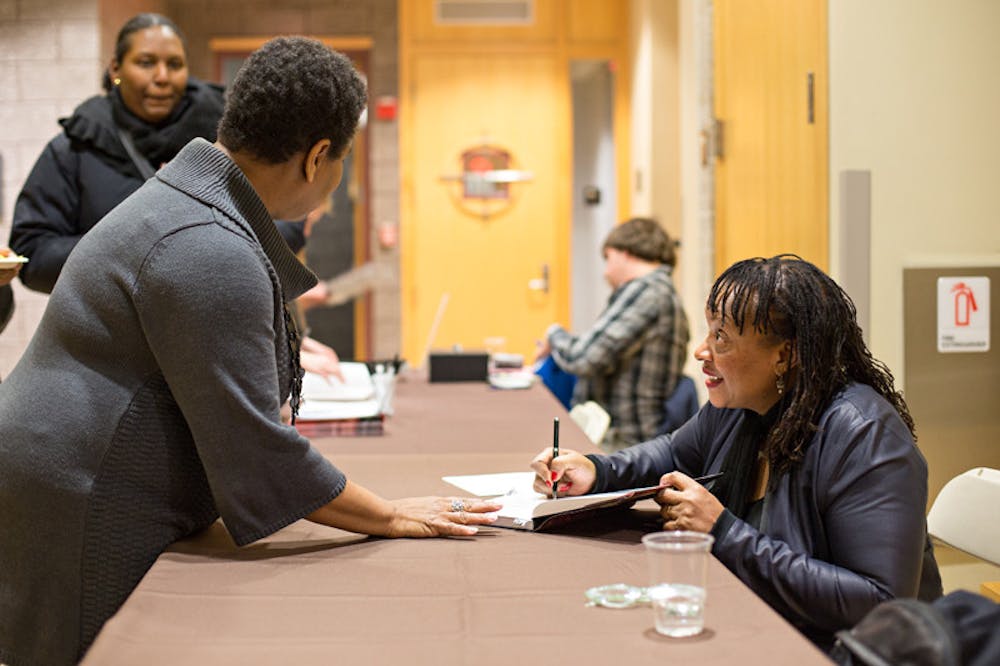Deborah Willis, chair of the department of photography and imaging at the Tisch School of the Arts at New York University presented the 2014 Debra L. Lee Lecture on Slavery and Justice to a half-filled Smith-Buonano 106, entitled “Visualizing Freedom: Photography and Emancipation.”
Willis has been named a Guggenheim Fellow, Fletcher Fellow and MacArthur Fellow — also known as the ‘Genius grant’ — as well as one of the most important persons in photography by American Photography Magazine.
“She is one of the foremost African American scholars in this country working in the field of photography and the occupation of space,” Anthony Bogues, director of the Center for the Study of Slavery and Justice, told The Herald. “Not many scholars will do work she does.”
Prior to the lecture, Willis signed copies of her recently published book, “Envisioning Emancipation: Black Americans and the End of Slavery,” which she co-wrote with historian Barbara Krauthamer. The book features over 150 photographs dating from between the 1850s and the 1930s, many of which were previously unpublished, and commemorates the 150th anniversary of the Emancipation Proclamation.
The goal of the project was to present a more comprehensive history of slavery and emancipation than textual analysis alone can provide, Willis told The Herald. “I wanted to work with a historian to mold and blend the two stories together.”
Though the signing took place just prior to the presentation, the book sold out well before attendees filed into the lecture hall.
In his introduction to the lecture, Bogues said the book “presents series of images that challenge our perceptions about slavery and ... our perceptions about freedom.”
Willis’s slideshow, which accompanied her talk, primarily showcased images taken in the United States and Brazil in the years leading up to and following the Emancipation Proclamation. Some photographs portrayed subjugation, while many others conveyed the reaffirmation of dignity in the years during and after the Civil War.
This time period was both a significant turning point in American history and a time of progress for photographic documentation, Willis said, citing technological advancements and the expansion of portraiture beyond the sphere of the wealthy and powerful.
Willis’s analysis of each photograph in her slideshow expressed how subtle visual elements represent historical clues, illustrating how photography “introduced an idea of humanity” for those who had long been dehumanized. During the pivotal era surrounding emancipation, family photo albums grew thick with the documentation of slave women cradling their white charges. But abolitionist images, such as those of Frederick Douglass and Sojourner Truth, also began to circulate in wider and more public arenas, Willis said.
She also focused on an image of an unidentified washerwoman who worked in the Union Army, commenting on the woman’s confident posture, direct gaze and United States brass button pinned to her chest.
“We see her not as a servant girl, but as a woman who proudly worked with the Union army. We see her image of her own emancipation and how she envisions it,” Willis said, adding that these intersections between “freedom and patriotism” also portray an expansion of female identity.
Jasmine Johnson GS, who attended the event, praised Willis’ interdisciplinary approach of wearing her “historian’s hat” as well as her “artistic hat.”
“She’s able to analyze the work through both angles, which is not something we usually think about when we’re talking about slavery and emancipation.”
Andre Bradley, a graduate student at the Rhode Island School of Design, also spoke of the discussions these images can generate.
“From a historical standpoint, (the lecture) was really powerful and poignant and timely,” he said. “It’s all about learning how to use images to start a different dialogue or redirect a certain historical notion to a place that’s more productive for you as a person, and for society.”
“The cultural significance of her work is that it brings to the floor a set of photographs and archives that discuss the ways in which African Americans attempted and achieved emancipation,” Bogues told The Herald.

ADVERTISEMENT




